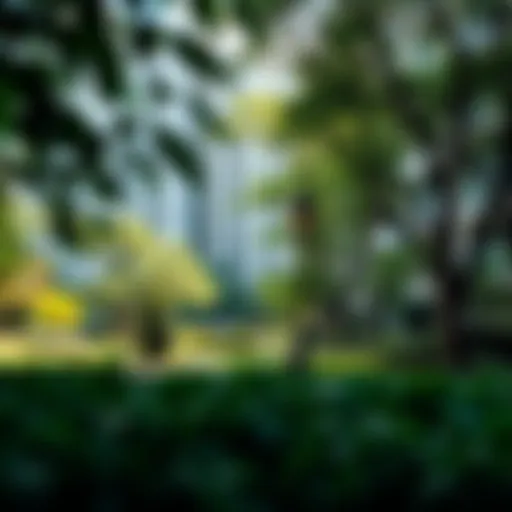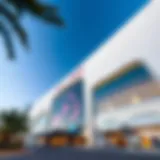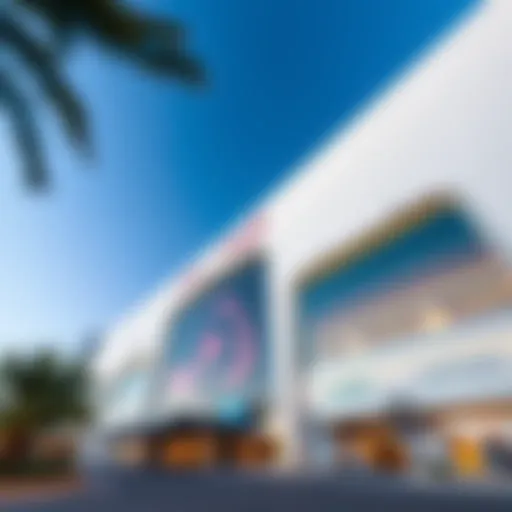Dubai's Global Village: Cultural and Economic Insights


Intro
Dubai has long been a beacon of innovation and diversity. This bustling metropolis stands at the crossroads of tradition and modernity, being a city where cultures intermingle, ideas flourish, and opportunities abound. The concept of a global village here is not just a metaphor; it is a tangible reality that shapes the urban fabric of the emirate.
The essence of a global village signals a confluence of cultures, transcending geographical boundaries. With residents hailing from over 200 nationalities, engaging in a melting pot of languages, customs, and culinary delights, Dubai serves as a live canvas illustrating the beauty of cultural exchange. The following sections dive into the intricate tapestry of cultural and economic dynamics facilitated by this unique environment, exploring how the different threads come together to forge a vibrant urban life.
Investors, real estate developers, and urban planners have recognized this dynamic landscape as ripe for investment. With the massive influx of expatriates and tourists alike, the demand for residential and commercial spaces continues to surge. This article first looks into market trends, followed by investment opportunities ripe for exploration.
Conceptual Foundations of a Global Village
A thorough understanding of the conceptual foundations of a global village is pivotal in the context of Dubai's multifaceted urban landscape. The term 'global village' encapsulates more than just an amalgamation of cultures; it represents a significant shift in how communities connect, share resources, and adapt to the ever-evolving global scenario. Comprehending this concept enables stakeholders—from investors to urban developers—to appreciate better the intricate dynamics of social interaction and economic interdependence that characterize Dubai's vibrant environment.
Definition and Origins
The phrase 'global village' was first popularized by Marshall McLuhan, who suggested that advancements in communication technologies would shrink geographical barriers, allowing people across the world to engage as if they lived next door. While McLuhan’s ideas emerged in the 1960s, the relevance of these concepts has only gained momentum with the rise of the internet and globalization. In Dubai, the global village manifests as a melting pot of countless cultures, each contributing to a richer, more diversified community fabric.
The origins of this concept in Dubai can be traced back to its rapid economic development and strategic location as a trade hub. Situated at the crossroads of Europe, Asia, and Africa, Dubai has always attracted a diverse range of populations seeking opportunities in trade and industry. This influx of different cultures initiated a continuous dialogue of influences, transforming Dubai into an embodiment of a global village.
Theoretical Framework
Understanding the theoretical frameworks that support the notion of a global village in Dubai requires diving into both sociocultural and economic models. Models of globalization emphasize the significance of cultural exchange as a catalyst for innovation and creativity. For example, the economic theory posits that the integration of global markets leads to increased trade, fostering competitive advantage for local businesses.
On the sociocultural front, frameworks such as transnationalism emphasize the interconnectedness of people across borders, highlighting fluid identities that emerge in such settings. In Dubai, these theoretical insights illuminate how international perspectives shape local culture, creating a unique blend that stands out in the global arena. The coexistence of different traditions, languages, and worldviews not only enriches everyday life but also shapes policies and economic strategies at various levels.
Cultural Implications
The cultural implications of a global village in Dubai are profoundly nuanced. The city's multicultural heritage cultivates an environment where citizens and expatriates alike engage in cultural exchange. Festivals, community gatherings, and various events provide spaces for interaction, allowing participants to showcase their traditions while learning about others.
- Enhanced Creativity and Innovation: Different backgrounds bring unique perspectives that can inspire creativity. Think of how local art festivals showcase international artists and create collaborative projects that echo this cross-pollination.
- Social Cohesion and Challenges: While diversity promotes enrichment, it can also lead to conflicts. Understanding different perspectives becomes central for fostering social cohesion. Recognizing and addressing cultural sensitivities must be prioritized to mitigate potential tensions.
The Dubai Context
Understanding the context of Dubai is crucial when exploring its position as a modern global village. This section will investigate various elements that shape Dubai's urban and economic landscape, offering insights that are valuable for investors, developers, and professionals alike.
Dubai's Urban Development History
Dubai's dramatic transformation from a humble fishing village into a thriving metropolis is a testament to visionary leadership and strategic planning. The discovery of oil in the 1950s catalyzed significant changes, leading to heavy investments in infrastructure and development initiatives.
The construction of the Dubai Creek in the late 19th century set off an era of trade that gradually paved the way for economic diversification. In the 1990s, the government initiated the "Dubai Internet City" and "Dubai Media City" projects, which attracted global tech firms and media conglomerates. These investments laid the groundwork for Dubai's evolution into a global business hub, welcoming multinational corporations and fostering a cosmopolitan lifestyle.
Moreover, this historical backdrop is critical in understanding how Dubai has now embraced innovative urban planning. High-rise buildings like the Burj Khalifa symbolize not just architectural prowess but also the ambition of a city intent on becoming the ultimate global destination.
Real Estate Trends in Dubai
As a cornerstone of its economic development, the real estate market in Dubai has experienced significant ebbs and flows. Initially buoyant, the market faced challenges following the global financial crisis in 2008. However, since then, targeted policies have encouraged recovery and growth.
Currently, Dubai's real estate scene is marked by a diversification of offerings, promising high returns on investments. Projects such as the Dubai Marina and Downtown Dubai showcase luxury living and innovative commercial spaces, catering to both local and international demand. Investment in off-plan properties has also surged, fueled by attractive payment plans and the potential for capital appreciation.
The rise of freehold properties further demonstrates an effort to attract foreign investment, as non-residents can now own properties outright. Additionally, developers are incorporating sustainability and smart technologies, making future projects more aligned with global standards while meeting the evolving preferences of buyers.
Integration of Global Concepts
Today, Dubai's approach to integrating global concepts is reflective of its status as an international hub. By opening its doors to diverse cultures and ideas, Dubai has cultivated a unique environment that fuses traditions with modern practices.
The influence of global architectural styles can be seen in numerous developments across the city; structures like The Louvre Abu Dhabi not only incorporate international art but also symbolize the commitment to cultural exchange. This blend enhances Dubai's position as a melting pot, encouraging investment and tourism while facilitating cultural dialogue.
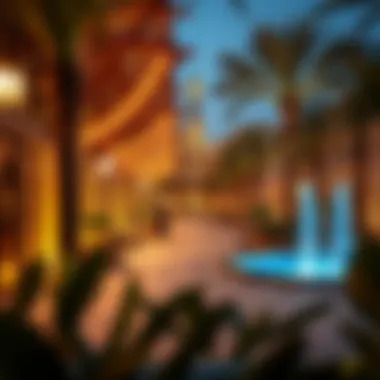

Economically, the adoption of global business practices alongside local customs is essential in sustaining growth. Businesses here often combine Western operational models with an understanding of Middle Eastern culture, creating a unique business landscape that appeals to multinational companies and local artisans alike.
"Dubai's cultural richness and diversity provide a fertile ground for innovation, making it an attractive destination for those looking to invest in the future of urban living."
For more insights and detailed information on Dubai's developments, visit Wikipedia and Britannica.
Architectural Innovations
The architectural innovations in Dubai serve as a cornerstone of its identity as a global village. They meld tradition with modernity, reflecting the city’s ambition to create an environment that nurtures cultural exchanges while catering to the needs of a diverse population. These innovations not only enhance the aesthetic appeal of the city but also promote sustainability, community engagement, and economic growth, blending functionality with artistry.
Design Elements of Global Villages
Global villages typically showcase diverse architectural styles that reflect the myriad of cultures present within them. In Dubai, this is seen through various neighborhoods where elements from Middle Eastern heritage coexist alongside modern international influences. For instance, the intricate designs of wind towers juxtapose sleek, glass skyscrapers, resulting in visually striking skylines that tell a story.
Common design elements that characterize these urban spaces include:
- Open spaces: Parks and plazas are integrated into the fabric of urban life, promoting community gatherings and cultural events.
- Mixed-use buildings: Combining residential, commercial, and recreational spaces creates vibrant neighborhoods that facilitate interaction between different cultures.
- Cultural hubs: Structures designed specifically for cultural activities — galleries, museums, and performance art centers — serve to celebrate and preserve diverse traditions.
These design innovations foster an inclusive atmosphere, essential for attracting both residents and tourists alike. The aim is to create a more "livable" space where different communities can thrive side by side, learning and sharing from one another.
Sustainability Initiatives
Sustainability is a key focus of architectural innovation in Dubai’s global village concept. With an eye towards preserving the environment while accommodating rapid growth, various initiatives are underway to build a sustainable urban ecosystem. Here are some notable efforts:
- Green building practices: Developers are increasingly adopting sustainable construction techniques, opting for eco-friendly materials and energy-efficient systems. For instance, projects like the Burj Khalifa incorporate solar panels and water recycling systems, minimizing their environmental footprint.
- Smart city technologies: Integration of smart technologies enhances efficiency and resource management. Wireless sensor networks, for example, help in monitoring energy consumption and improving waste management processes.
- Emphasis on public transportation: Dubai’s commitment to sustainability is evident in its investment in robust public transportation options, such as the Dubai Metro, which aims to reduce traffic congestion and overall carbon emissions.
"Sustainability isn't just an option; it's a necessity for future urban life. The architectural innovations in Dubai prioritize eco-consciousness, providing a blueprint for cities worldwide."
Design and sustainability intertwine in Dubai’s global village, creating a model for future developments. These architectural innovations not only shape the physical space but also create an environment that supports social interaction and economic potential. As Dubai continues to evolve, the city stands as a testament to how forward-thinking designs foster a rich tapestry of cultural and economic dynamics.
Economic Impact
The economic impact of a global village in Dubai is both profound and multifaceted. This section will illustrate how this innovative concept not only propels the local economy but also enriches the cultural landscape, making Dubai a hotbed for investors and entrepreneurs alike.
Investment Opportunities
Investment opportunities in Dubai’s global village are as abundant as they are diverse. The strategic positioning of Dubai as a central hub for trade and commerce enhances its appeal. Investors can tap into various sectors, including real estate, retail, and hospitality. Notably, the government's proactive approach, along with various free zones, encourages foreign direct investment, making it less cumbersome to establish and operate businesses.
In terms of real estate, projects like the Dubai Marina and Palm Jumeirah have set new standards. With many developments catering to all budgets, the potential for capital appreciation is immense. Investors can also take advantage of the short-term rental market, driven by tourism and the influx of expatriates.
Additionally, as cultural festivities and community events draw visitors, businesses surrounding these activities can flourish. For example, during the Dubai Shopping Festival, retail outlets often see a substantial uptick in sales, leading to high return on investment for stakeholders involved in retail and event management. However, regulatory frameworks must be understood and adhered to, keeping in mind restrictions and guidelines set forth by local authorities.
Job Creation and Economic Diversity
As a global village evolves in Dubai, so too does the spectrum of job creation and economic diversity. This transformation leads to a workforce that is not only cosmopolitan but also skilled in various fields. As businesses bloom, new job vacancies arise in sectors such as technology, finance, and hospitality, catering to both local residents and expatriates.
For instance, a significant role is played by large multinational corporations setting up shop in Dubai. Companies like Emirates Airlines and Emaar Properties have become market leaders. They draw talent from around the world, creating a mosaic of cultures that enhances workplace dynamics and stimulates innovation.
Furthermore, small and medium enterprises, often the backbone of economic diversity, thrive within this environment. Initiatives such as Dubai Startup Hub encourage budding entrepreneurs by providing resources and mentorship. This contributes to an ecosystem that values creativity and forward-thinking.
> "An investment in knowledge pays the best interest." – Benjamin Franklin
That said, with the influx of diverse cultures, it’s crucial to address potential challenges, such as labor market competitiveness and social disparities. Local communities need to adapt and thrive in this transformative environment, ensuring that the benefits of increased economic activity are equitably shared.
Understanding the economic impact of a global village in Dubai is vital. Both investors and developers should consider the dynamic interplay of these factors, as they hold the keys to a prosperous venture in this fascinating city.
Cultural Exchange Mechanisms
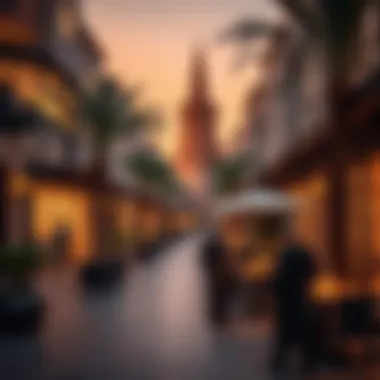

Cultural exchange is the heart and soul of a global village like Dubai. Within this bustling metropolis, diverse cultural backgrounds come together, creating a rich tapestry of traditions, languages, and ideas. This section explores the mechanisms through which cultural exchange manifests, highlighting its significance in fostering community ties, enhancing economic development, and promoting global understanding.
Community Events and Engagement
One of the quintessential means of promoting cultural exchange in Dubai is through community events and engagement initiatives. These gatherings serve as a platform for residents and visitors alike to immerse themselves in various cultures. Festivals celebrating Eid, Diwali, and Christmas, for example, not only showcase local traditions but also invite participation from different nationalities. Such events help demystify cultural practices, allowing individuals to connect on a personal level.
Benefits of Community Engagement:
- Strengthened ties: These events foster camaraderie, creating a sense of belonging among participants.
- Knowledge sharing: Engagement allows for the sharing of stories, skills, and experiences from various cultures.
- Economic boosts: Events can drive tourism and stimulate local businesses, benefitting the wider community.
One prime example of community engagement is the Dubai Shopping Festival, which showcases a myriad of cultural performances, food stalls, and artistic exhibitions. As individuals queue for the chance to sample international delicacies or experience traditional dance, they develop an appreciation for each other’s backgrounds.
Challenges of Cultural Integration
However, the path to effective cultural exchange is not without its bumps. While Dubai's multicultural fabric is commendable, it faces challenges regarding integration. Different customs and practices can at times clash, creating friction that needs navigating. Here are some challenges worth considering:
- Misunderstandings: Language barriers and varying cultural contexts can lead to misinterpretations, causing unintended offense.
- Social stratification: Economic disparities among residents can create social divides that impede genuine cultural exchange.
- Cultural preservation: As global influences permeate local traditions, there is a risk of diluting or sidelining indigenous cultures in favor of more dominant global narratives.
Despite these challenges, Dubai has made significant strides in addressing cultural integration. Initiatives like cultural awareness programs in schools and the promotion of interfaith dialogue are just a couple of avenues being explored.
"Cultural exchange is not just about sharing; it's about creating spaces where all voices can be heard and respected."
Ultimately, as stakeholders in Dubai's future, understanding these cultural exchange mechanisms—both their benefits and challenges—is crucial. It can guide urban development and create an environment where diverse cultures not only coexist but thrive together.
Tourism and Visitor Experience
Tourism acts as a linchpin in the dynamics of a global village, serving as both a catalyst for cultural exchange and an engine for economic growth. In the context of Dubai, the visitor experience is crafted with meticulous attention, where every corner invites exploration and engagement. This section examines essential elements of tourism in Dubai's global village, emphasizing attractions, amenities, and the underlying demographic insights that shape visitors' preferences.
Attractions and Amenities
Dubai is a patchwork of breathtaking attractions that draw millions of visitors from around the globe. These spots not only showcase the city's architectural brilliance but also embody the essence of cultural integration. Notable examples include:
- Burj Khalifa: This iconic skyscraper stands tall as the tallest building in the world, offering unparalleled views of the city and beyond.
- The Dubai Mall: More than just a shopping destination, it features an indoor ice rink, an aquarium, and a plethora of dining options that cater to varied palates, making it a hub for social interactions.
- Global Village: A unique theme park that integrates the cultures of more than 90 countries through food, entertainment, and shopping, reflecting Dubai's spirit of hospitality and diversity.
These attractions serve dual purposes—enticing tourists and fostering local pride. The amenities accompanying these sites, such as guided tours, mobile applications, and transport services, enhance the overall experience, ensuring visitors feel connected not only to the attractions but to the city itself.
However, recent trends reflect an increasing importance of providing immersive experiences over mere sightseeing. Visitors are increasingly seeking interactive and personalized engagement. For instance, culinary tours that introduce guests to the flavors of the Middle East provide opportunities to engage with local chefs and traditional methods of cooking—creating memories that are far more than superficial snapshots.
Visitor Demographics and Preferences
Understanding who visits Dubai and why can help stakeholders tailor their offerings to meet burgeoning expectations. According to data, tourists flock to Dubai primarily from India, Saudi Arabia, the UK, and China, each demographic contributing distinct preferences and cultural insights:
- Families: Seek attractions that offer kid-friendly activities, like theme parks and interactive museums.
- Young Professionals: Often interested in nightlife, high-end dining, and entertainment options that showcase global artists.
- Cultural Enthusiasts: Engage with art exhibitions, historical sites, and festivals that celebrate diverse traditions.
This varied demographic landscape highlights a shift towards a more diversified pool of visitors. Notably, the rise of solo female travelers reflects changing social norms and a trust in the city's safety and hospitality.
In summary, tourism in Dubai is not just about numbers; it's about weaving a rich tapestry of cultural and economic narratives that resonate with a global audience. Stakeholders need to pay attention to these evolving visitor preferences, ensuring the attractions and amenities provided are not only in tune with international standards but also reflective of the vibrancy that Dubai promises.
"The essence of a global village is the intersection of cultures, where tourism fosters understanding and appreciation."
This intricate interaction between tourism, community engagement, and cultural exchange is what sets Dubai apart on the world stage.
Social Dynamics
The concept of a global village in Dubai transcends mere architectural design or economic models; it profoundly influences the social fabric of the city. This section seeks to spotlight how social dynamics play a pivotal role in shaping the communal experience within this metropolitan marvel. With a rich tapestry of cultures woven into the daily lives of its residents, understanding social dynamics becomes essential not only for societal cohesion but also for fostering a sense of belonging among diverse groups.
Impact on Local Communities
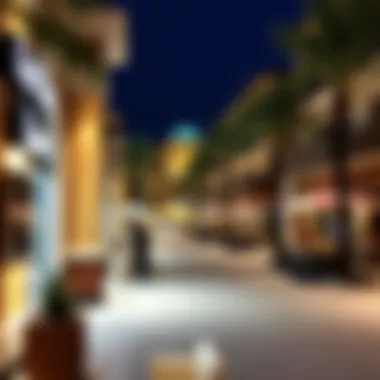

At the heart of Dubai is its citizens and expats alike. The city's inhabitants hail from numerous corners of the globe, creating a melting pot of ideas, beliefs, and traditions. This cultural diversity fosters unique interactions and collective innovations, making local communities vibrant and dynamic.
For instance, neighborhood gatherings often highlight different cultural festivals, where food stalls and art displays showcase the richness of the varied cultures. Such initiatives strengthen community ties and promote mutual respect, leading to enhanced social integration.
"In a global village, the threads of different cultures are interwoven, crafting a more cohesive and resilient community."
Moreover, the opportunities for collaboration among community members in Dubai are substantial. Local organizations often encourage projects that bring together people from different backgrounds. This encourages the sharing of skills and knowledge, ultimately benefiting all involved.
The impact on local communities also extends to the younger generations. Exposure to varied perspectives enables children to grow into open-minded adults, fostering a society that values diversity, inclusivity, and respect.
Housing and Living Standards
The housing landscape in Dubai reflects the ongoing shift towards a more integrated community. Developers are increasingly adopting designs that cater not just to luxury but also to communal living. These housing projects often incorporate amenities designed to encourage social interaction, thus enhancing the quality of life.
In many neighborhoods, shared spaces like parks, community centers, and recreational facilities serve as hubs for socializing. They offer residents a chance to connect, no matter their background. This sense of community is a vital ingredient in boosting living standards.
Additionally, the rise of mixed-use developments has changed the way people perceive their living spaces. Residents enjoy convenience with retail, schools, and workplaces located within walking distance, creating an environment that is not only functional but also conducive to social exchange.
In closing, the social dynamics of a global village in Dubai promote a sense of unity amid diversity. They enhance living standards and foster a sense of belonging among residents, making Dubai not just a place to live but a community where people from various backgrounds can thrive together.
Future Perspectives
Future perspectives on the concept of a global village in Dubai are critical for understanding how urban living, economic dynamics, and cultural exchange may evolve in the coming years. With the rapid pace of globalization and technological advancement, Dubai stands at a pivotal point where its policies and strategies can define the future for not just its residents but also for the international community.
Urban Development Projects
Urban development projects in Dubai conjure images of grandiose skyscrapers and opulent shopping malls, but they also reflect a more profound vision of a cohesive global village. The government has initiated multiple projects aimed at enhancing both livability and sustainability. For instance, the Dubai Creek Tower, when completed, is set to be the tallest structure in the world, symbolizing the ambition and forward-thinking nature of the city.
Moreover, projects like the Expo 2020 site are reshaping the landscape to accommodate a more diverse range of visitors and residents. Such initiatives are more than just construction efforts; they demonstrate a commitment to creating spaces where cultural interactions can thrive. They may also serve as incubators for innovative ideas that address local and global challenges. This synthesis of local culture and global input is essential for the enduring vitality of the Dubai global village.
"Fostering a sense of community through forward-thinking urban development is essential for creating a vibrant global village."
The impact of such developments can’t be overstated, especially in attracting foreign investments and skilled labor, thereby enhancing Dubai’s reputation as a business hub.
Adapting to Global Changes
Adapting to global changes is a crucial aspect of ensuring the longevity of the global village concept in Dubai. As new technologies emerge and sociopolitical landscapes shift, the necessity for flexibility in urban planning becomes apparent. The city hasn’t shied away from embracing new technologies, from smart city initiatives to green building practices.
Another vital consideration is how geopolitical events influence investment flows and social dynamics within Dubai. For example, changes in visa policies can either bolster or hinder the influx of expatriates, significantly altering the cultural fabric of the city. Thus, being proactive about these developments is crucial to securing a bright future.
Furthermore, cultural adaptability is equally important. Enhancing intercultural dialogue and fostering understanding between diverse communities is paramount to achieving a harmonious existence. Programs that promote cultural exchange, such as art festivals and educational workshops, serve not only to unite different cultures but also to prepare for future global challenges.
Culminations and Implications
Understanding the implications of a global village in Dubai involves examining multiple layers of interconnected elements. This intricate concept not only shapes cultural exchanges but also bolsters economic activities. By analyzing the findings presented throughout the article, we can glean insights into how these dynamics are functioning together to create a unique environment in Dubai.
Summarizing Key Findings
The exploration has highlighted a series of key aspects:
- Cultural Exchange: Dubai serves as a melting pot, where diverse cultures converge, fostering an environment ripe for collaboration and innovation.
- Economic Growth: The influx of international businesses and investors has bolstered Dubai's economy, making it a significant player on the global stage.
- Urban Development: Significant urban projects signal a shift towards more integrated living spaces that cater to a multicultural population.
These findings underscore the necessity for stakeholders to recognize the benefits of cultural collaboration and economic interdependence in real estate and business strategies.
Recommendations for Stakeholders
For those invested in Dubai’s horizon, recommendations emerge based on the insights gleaned:
- Engagement Strategies: Develop robust community engagement initiatives that celebrate cultural diversity and foster inclusivity, enhancing social cohesion within neighborhoods.
- Investment in Sustainability: As urbanization continues, encourage sustainable practices in construction and development. This appeals to conscientious investors and helps protect the environment.
- Market Research: Continuously assess visitor demographics and preferences to tailor offerings in tourism and real estate developments. Understanding the needs of a diverse clientele can drive profitability.
Ultimately, stakeholders must cultivate an ecosystem that harmonizes cultural and economic dynamics in order to fully capitalize on the opportunities that a global village in Dubai presents. The implications ripple beyond the immediate market, influencing regional trends and positioning Dubai as a central hub for global interconnectedness.
"The future of Dubai's global village will largely depend on our collective ability to adapt and innovate culturally and economically."

